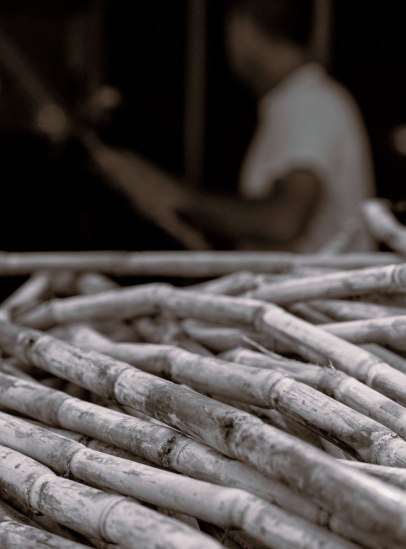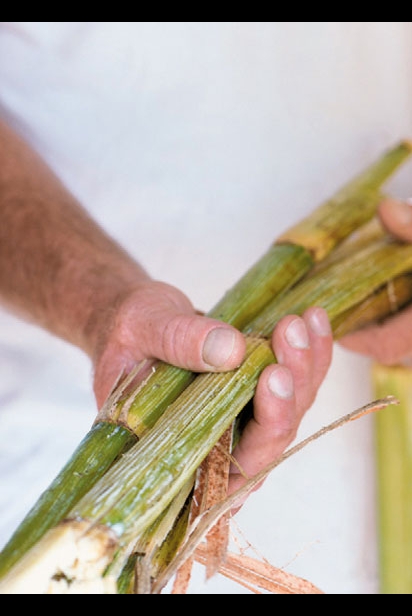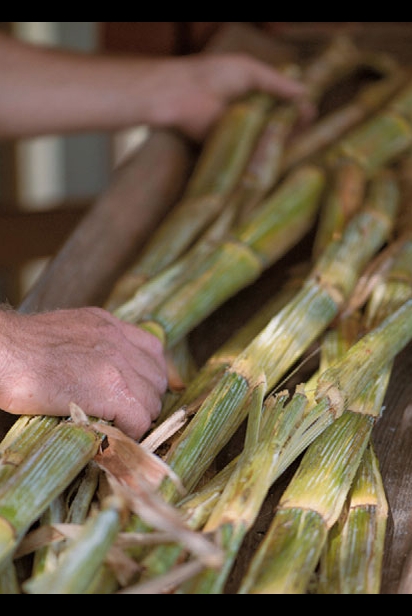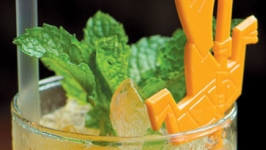Drinking Up a Storm: Why The Hurricane Cocktail Still Matters
Peruse travel sites like Yelp and Trip Advisor and you will see that topping most “to do” lists of visitors to New Orleans is “Drink a Hurricane.” Poke around most New Orleanians’ attics and you’ll stumble on a dusty Hurricane glass from Pat O’Brien’s, usually stuffed with old Mardi Gras beads, which gets hauled out once a year to adorn a mantel during Carnival. How did this recently crafted, rum-based concoction become almost as emblematic of our city as the Sazerac, which has a more storied (and longer) history?
To understand the Hurricane’s popularity, it’s worth taking a trip back to the origins of the drink. Despite New Orleans’ proximity to the Caribbean, rum was never the go-to spirit for the French colonists who settled here in the 1700s. It wasn’t the quality product it is today and was viewed by Creoles and Americans alike as a low-rent option. Instead, French colonists preferred familiar beverages from France: cognac, brandy and wine.
Americans brought their taste for whiskey to Louisiana after we joined the United States with the Louisiana Purchase in 1803. When Louisiana started making sugar in the 19th century, some plantations distilled a rumlike product called tafia, but this was created strictly for home consumption. Inventories of saloons and liquor suppliers bear this out. While rum was available for sale throughout the 19th and early 20th century, the quantities purchased paled when compared to that of whiskey. Whiskey was the American spirit until Prohibition.
Prior to Prohibition the country consumed far more beer than spirits. But it’s hard to smuggle beer. Or cut it. Or doctor its flavor. Booze, on the other hand, doesn’t spoil and, no matter how nasty it is, a bit of sugar or juice or other flavoring can make it tolerable, if not tasty. Americans looked to Great Britain and Canada to supply them with something more aged than moonshine, but New Orleanians turned south for our booze and soon charter boats were booking cruises to nearby Cuba and the Caribbean.
While there, thirsty travelers discovered the joys of rum. By then, it had transformed from a product only a pirate could love into something smoother. Also, in the spirit of Jean Lafitte, skiffs laden with rum were steadily sneaking it into New Orleans’ bays and harbors under the noses of federal agents. Much of this rum was distributed throughout the South, establishing New Orleans as a booze smuggling hub. In 1926, federal agents noted that more liquor was smuggled through the city than citizens could possibly drink, no matter how hard they tried. One person who enjoyed success under Prohibition was a man named Pat O’Brien. He ran a very popular speakeasy in the French Quarter called Club Tipperary. Entrance to the club depended on knowing its password: Storm’s A-brewing.
Prohibition lasted from January 1920 to December 1933, 14 years without legal whiskey production in the United States. When Prohibition finally ended, the only well-aged whiskies available were from Canada and Great Britain. American whiskey went directly into barrels to “improve.” Not long after the first barrels of American whiskey became available (still not nearly enough to meet demand) Great Britain entered World War II.
Now, instead of running Scotch, British ships started running guns, which limited our whiskey supply to what we had locally and what we could get from Canada. The U.S. entered the war in 1942 and American whiskey distillers were informed they had to stop making whiskey and start making airplane fuel, or “cocktails for Hitler,” (apparently the manufacturing process is similar). With even less whiskey available, rum came back in vogue while the Andrews Sisters crooned “Rum and Coca-Cola.”
And here we arrive at the birth of the Hurricane.
After the repeal of Prohibition, Pat O’Brien closed the Club Tipperary and opened his namesake bar. He soon faced the same whiskey shortage and rum abundance of many New Orleans bar owners, but instead of mixing yet another rum and Coke, he challenged his bartenders to create a new rum-based drink, and the Hurricane was born. Its name was inspired by his “Storm’s A-brewing” password and O’Brien served it in an iconic hurricane-lantern-shaped glass to solidify its name.
The drink’s original recipe featured a mixture of rum, passion fruit juice and lime. As the drink gained popularity, the recipe morphed. Now if you order a Hurricane, there is no telling what may arrive in your glass. At Pat O’Brien’s, it’s made from a mix. Other bars around the city usually make up their own version featuring pineapple juice, orange juice and whatever else they may have handy. French Quarter tiki bars Latitude 29 and Tiki Tolteca use passion fruit juice for drinkers who want to sample the drink in its original form.
To some degree, it almost doesn’t matter what’s in the drink or even what it tastes like. What matters is the idea of the Hurricane and drinking it while in New Orleans, maybe even at its birthplace, Pat O’Brien’s. The Hurricane owes a lot of its popularity to tourists in New Orleans.
There is nothing serious about the flavor of the Hurricane. Our official cocktail, the Sazerac, features rye, and its primary balancing flavor is anise/licorice, strong and distinct flavors that do not sit well on the occasional drinker’s palate. It is complex. In contrast, a Hurricane is made with rum and the more globally popular mixer of fruit juice. Though a well-made Hurricane should have a nice balance of sour and sweet, many taste like snoball syrup. As a rule, Americans prefer sweet, straightforward drinks to dark and complicated ones. And once in a while we all prefer something not serious to something dark and complicated. Score one for the Hurricane in TASTE.
Hurricanes are extravagant. Served in the hurricane-lantern-shaped glass, they are often adorned with oranges and cherries. While you can see tourists strolling around the Quarter sipping them from paper go-cups, most folks prefer having the full experience of ordering one in the over-the-top glass with all the accoutrements. Not many drinks get their own festive container, especially one so graceful and definitive. Drinking a Hurricane embodies what most people come to New Orleans for: fun. Score another for the Hurricane in HAVING A GOOD TIME.
Rum ambled up from the Caribbean and many folks, New Orleanians included, place our city’s sensibilities at the northern edge of the Caribbean rather than the southern edge of the United States. People like a drink that embodies that geographic idea. Although recently rum has gotten its due as a “legitimate” spirit, sporting expensive labels and intended to be sipped and savored, for most folks rum still evokes images of pirates, indolence and the beach. Though New Orleans is short on the latter, we have ample manifestations of the first two. The easy overlapping of the associations of rum and New Orleans support rum drinking as more than fitting in this city. Score one for NOT GETTING ANYTHING DONE (with apologies to pirates).
Finally, we have the name. Several drinks, many of them of the tiki persuasion, are named for all manner of weather calamities. Finishing one implies you survived a storm/strong drink. This is to be expected and experienced in New Orleans, one of the few cities in the United States where people come to drink in quantities they cannot at home. Drinking a Hurricane also gives you permission to act a fool because rarely do people have only one. Despite the dangers implicit in its name, if made even tolerably well a Hurricane goes down easily—and after drinking two of the lantern-size glasses one has consumed six to eight ounces of alcohol. A cup of booze gives you plenty of license to do what you’ve been intending to but afraid to do back in Des Moines and is a handy scapegoat for your actions last night. Score one for GETTING DRUNK.
And unlike the shrouded origins of gumbo or red beans, we know its birthplace. There’s an actual sacred site you can visit, the shrine where you taste the nectar and dance in the firelight with Bacchus. Visitors raise the cup to their lips, drink in New Orleans and are transformed, tapping into their inner sybarite. They live that moment to the extreme, because they know it will end when they board the plane to go home.
Though it’s the ideas the Hurricane embodies more than anything else that has contributed to its popularity, it is becoming easier to find versions that have that intriguing balance of sour and sweet. The craft cocktail movement has left a mark on all kinds of cocktails, and bartenders and drinkers alike have put more craft into all their cocktail-making, even the Hurricane. In fact, Tales of the Cocktail’s 2014 cocktail competition asked bartenders to re-imagine the Hurricane (keeping a minimum of one rum and passion fruit to remain true to the drink). The farm-to-table movement has given us all a preference for food and drinks that taste fresher: actual fruit juice and fruit purées instead of mixes and syrups. A number of great local rums are coming out of Louisiana, such as Old New Orleans Rum and Bayou Rum. Tiki bars have become popular again, with Latitude 29 and Tiki Tolteca thoughtfully crafting our summer-worthy tiki drink.








